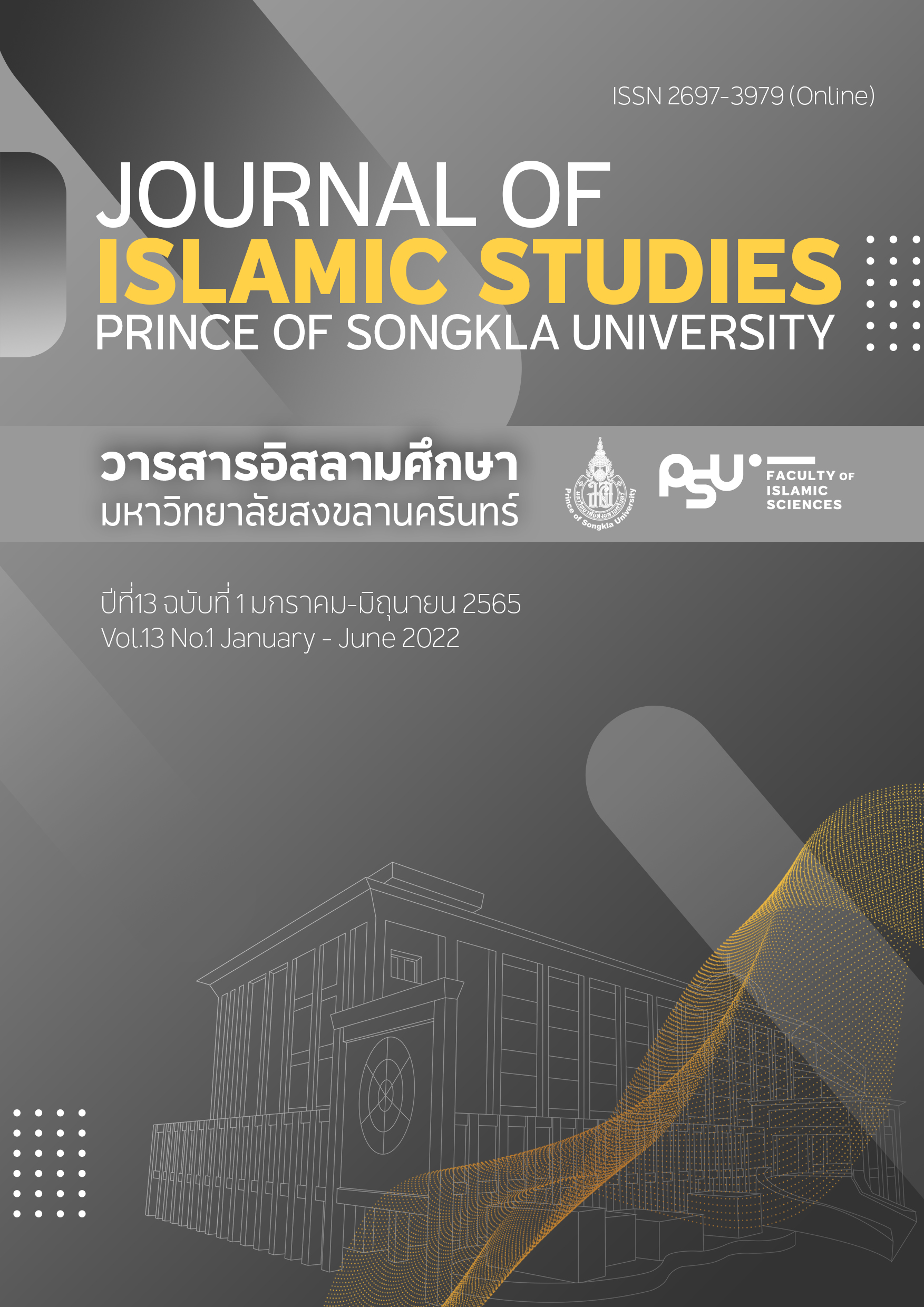“Ислам” (อิสลาม): การศึกษาอุปลักษณ์เชิงมโนทัศน์ในภาษารัสเซีย
คำสำคัญ:
อิสลาม, อุปลักษณ์เชิงมโนทัศน์, ภาษากับความคิด, ภาษารัสเซียบทคัดย่อ
จุดประสงค์ บทความดังกล่าวมีวัตถุประสงค์ในการศึกษาถ้อยคำอุปลักษณ์ที่สะท้อนมโนทัศน์เกี่ยวกับคำว่า “Ислам” (อิสลาม) ในภาษารัสเซียตามแนวทางภาษา ศาสตร์ปริชาน
วิธีการศึกษา งานวิจัยชิ้นนี้เป็นงานวิจัยเชิงคุณภาพ เน้นศึกษาข้อมูลที่ปรากฏถ้อยคำว่า “Ислам” (อิสลาม) จากงานเขียนวิชาการ งานเขียนกึ่งวิชาการ หนังสือพิมพ์ และข้อมูลเบ็ดเตล็ดในคลังข้อมูลภาษารัสเซียแห่งชาติ
ผลการศึกษา พบว่าถ้อยคำอุปลักษณ์สะท้อนมโนทัศน์เกี่ยวกับอิสลามได้แก่ [อิสลาม คือ มนุษย์] [อิสลาม คือ วัตถุสิ่งของ] [อิสลาม คือ เครื่องมือทางการเมือง] [อิสลาม คือ วัฒนธรรมหรืออารยธรรม] [อิสลาม คือกฎหมาย] [อิสลาม คือ สิ่งที่เกี่ยวกับชีวิต] มโนทัศน์ดังกล่าวสอดคล้องกับความเข้าใจในมุมมองทางศาสนาที่ว่าอิสลามไม่เพียงเป็นศาสนาเท่านั้นแต่คือวิถีชีวิตของมนุษย์ในหลากหลายมิติ อิสลามได้รับการกล่าวถึงทั้งในแง่ดี อาทิ การสนับสนุนให้เกิดสันติภาพและความยุติธรรมในสังคมมนุษย์ และในแง่ร้าย อาทิ การทำให้เกิดความขัดแย้งอีกทั้งยังสร้างความหวาดกลัวในสังคมมนุษย์
การนำผลวิจัยไปใช้ ผลของวิจัยชิ้นนี้สามารถใช้เพื่อเป็นพื้นฐานในการสร้างความเข้าใจถึงการรับรู้เรื่องราวเกี่ยวกับอิสลามในบริบทของผู้ที่ใช้ภาษารัสเซีย และเป็นกรณีศึกษาในการศึกษาภาษากับความคิด ตลอดจนประเด็นการสื่อสารข้ามวัฒนธรรม
เอกสารอ้างอิง
Al Huchaimin, A. M. (2009). Explaining the fundamentals of faith. (2nd ed.). Nutcha printing.
Black, M. (1979). More about Metaphor. in A. Ortony (Ed.), Metaphor & Thought. Cambridge University Press.
Japakiya, I. L. (2011). Islam, the religion of peace. (3rd ed.). Matlitinmi Pattani.
Klinnamhom, R. (2013). Conceptual metaphor of happiness in Thai blogs. Institute of Culture and Arts journal Srinakharinwirot University, 14(2), 132-138.
KÖvecses, Z. (2002). Metaphor: A practical introduction. Oxford University Press.
Lakoff, G., & Johnson, M. (1980). Metaphors We Live By. The University of Chicago Press.
Mahama, M. (Editor). (2008). `Itlām withī hæng chīwit [Islamic way of life]. Institute of Research and Development for Health of Southern Thailand.
Malashenko, A. (2007). Islam dli͡a Rossii [Islam for Russia]. Russian political Encyclopedia.
Pasukdee, S. (2019). Conceptual metaphor of Happiness in Russian language in Cognitive linguistics. Journal of language and linguistics, 37(1), 31-73.
Pholboon, P. (2018). Conceptual Metaphors in J-POP. Humanities and Social Sciences, 35(2), 331-361.
Phulsawat, Y. (2015). Wityāsāt nai` ankun`ā [Science in the Quran]. Islammore. Retrieved from https://www.islammore.com/view/ 3766
Poruang, N. (2016). The study of the conceptual metaphor of the villain in the novel [Master’s thesis]. Kasetsart University.
Royal Institute Dictionary. (2011). `Itsalām [Islam]. Royal Society of Thailand. Retrieved from https://dictionary.orst.go.th
Royal Society of Thailand. (2017). Photnānukrom sap phāsāsāt phāsāsātthūapai chabap rātbanthit yotthān [dictionary of linguistic terms (General Linguistics) Royal Institute Edition]. Royal Society of Thailand.
Russian National Corpus. (2022). Islam. Russian National. Retrieved from https://ruscorpora.ru
Sahoh, I., & Sattar, Y. (2016). The idea of peace and conflict resolution in Islam. Kasetsart Journal of social sciences, 37, 333–344.
Shomali, W. (2006). Islam and peace. Center for Conflict Resolution & Reconciliation (CCRR).
Soviet Historical Encyclopedia. (1971). Uzbek Sultan Mukhammed. Soviet Encyclopedia.
Tabatabai, M. H. (2004). Phư̄nthān `itlām [Basic teachings of Islam]. 14 publications.
Tawichai, S. (2018). The Status of Research on Conceptual Metaphors in Thai. Journal of the Faculty of Arts, Silpakorn University, 40(2), 202-254.
Uppama, T. & Suetair, A. (2021). The concept of human civilization emplacement in Islam. Journal of Islamic Studies, Prince of Songkla University, 12(2), 16-28.
Uthman, S. (2015). Islam is a way of life. Islammore. Retrieved from https://www.islam more.com /view/3194
Vlacof, D. V. (2007). Ravil Gaynutdin: Theological interreligious dialogue can be started by discussing the Koran as the “third testament”. Blagovest-info. Retrieved from http://www.blagovest-info.ru/ index.php?ss=2&s =3&id=15835
Wongthai, N. (2012). Conceptual metaphors of death in Thai. Journal of language and culture, 31(1), 43-64.
World Population Review. (2021). Muslim Population By Country 2021. World Population Review. Retrieved from https://worldpopula tionreview.com/country-rankings/muslim-population-by-country
Yao, S. (2016). Conceptual Metaphors about Phoenix and Chickenin Mandarin Chinese. Journal of the Faculty of Arts, 45(2), 1-58.
Yarlikapov, A. (2014). Islam in the History of Russia. ISTORIYA. Electronic archive. Retrieved from https://arxiv.gaugn.ru /s207987840000684-1-1/
ดาวน์โหลด
เผยแพร่แล้ว
รูปแบบการอ้างอิง
ฉบับ
ประเภทบทความ
สัญญาอนุญาต
ลิขสิทธิ์ (c) 2022 วารสารอิสลามศึกษา มหาวิทยาลัยสงขลานครินทร์

อนุญาตภายใต้เงื่อนไข Creative Commons Attribution-NonCommercial-NoDerivatives 4.0 International License.
บทความทุกเรื่อง ที่ได้รับการตีพิมพ์ในวารสารอิสลามศึกษาเป็นแนวคิดของผู้เขียน มิใช่เป็นความคิดเห็นคณะผู้จัดทำและมิใช่ความรับผิดชอบของคณะวิทยาการอิสลาม กองบรรณาธิการไม่สงวนสิทธิ์การคัดลอก แต่ให้มีการอ้างอิงแสดงที่มา




